Publication
Article
Supplements and Featured Publications
Geographical Variation in Kidney Function Testing and Associations With Health Care Costs Among Patients With Chronic Kidney Disease and Type 2 Diabetes
Author(s):
ABSTRACT
OBJECTIVES: Clinical practice guidelines recommend at least annual testing of estimated glomerular filtration rate (eGFR) and urine albumin-creatinine ratio (uACR) for patients with chronic kidney disease (CKD) and type 2 diabetes (T2D). This study assessed the adequacy of eGFR and uACR testing in this patient population across the United States.
Study design: Observational real-world study
METHODS: Adults with CKD and T2D were identified from the Optum Clinformatics database (2015-2019). The eGFR and uACR tests were assessed nationally and by state. The proportions of tested patients and patients receiving adequate monitoring per clinical practice guidelines were analyzed during the 1-year period after T2D and CKD diagnosis, along with all-cause health care costs.
RESULTS: Among 101,057 adults with CKD and T2D, 94.1% had at least 1 eGFR test and 38.7% had at least 1 uACR test over 1 year. Only 20.3% of patients had adequate uACR monitoring; this was much lower than observed for adequate eGFR monitoring (86.6%). The eGFR testing rates were high across states (range, 79.5% [Colorado] to 97.3% [Alabama]); conversely, uACR testing rates were uniformly lower and showed wider variation (range, 14.0% [Maine] to 58.9% [Hawaii]). Mean annual all-cause health care costs were $28,636 and increased with CKD GFR stage. Lower uACR testing rates were associated with higher health care costs at the state level (Pearson r = –0.55; P < .01).
CONCLUSIONS: In the United States, uACR testing is underutilized, with large geographical variations in testing rates noted between states. Lower uACR testing rates were associated with higher health care costs. The lack of sufficient uACR testing raises concerns about CKD management in patients with T2D.
Am J Manag Care. 2022;28:S112-S119. https://doi.org/10.37765/ajmc.2022.89211
For author information and disclosures, see end of text.
Introduction
Diagnosis and staging of chronic kidney disease (CKD) in patients with diabetes should be assessed using estimated glomerular filtration rate (eGFR) and urine albumin-creatinine ratio (uACR), according to the Kidney Disease: Improving Global Outcomes (KDIGO) 2020 Clinical Practice Guideline for Diabetes Management in Chronic Kidney Disease.1 The results of eGFR testing characterize glomerular filtration functioning and have long been used to define the 5 CKD GFR (G) stages (ie, G1 [normal or high], eGFR ≥ 90 mL/min/1.73 m2; G2 [mildly decreased], 60 to 89 mL/min/1.73 m2; G3 [mildly to
severely decreased], 30 to 59 mL/min/1.73 m2; G4 [severely decreased], 15 to 29 mL/min/1.73 m2; and G5 [kidney failure], < 15 mL/min/1.73 m2).2 The uACR measures patients’ level of albuminuria, a sensitive indicator of morphological kidney damage or endothelial inflammation; it has also been used in defining the 3 CKD albuminuria (A) stages (ie, A1 [normal to mildly increased], uACR < 30 mg/g; A2 [moderately increased], 30-300 mg/g; A3 [severely increased], > 300 mg/g).3-5 The uACR is an important laboratory indicator of
CKD, as it reflects underlying kidney injury at an early stage in patients with T2D, even if eGFR initially remains unaffected.5-7 Thus, it is important to use both eGFR and uACR measurements to identify CKD and characterize disease severity.
Patients with type 2 diabetes (T2D) are at higher risk of developing CKD.8,9 In the United States, there were 37 million patients with diabetes in 2019,10 and 90% to 95% of the cases were T2D.11 Approximately 1 of 3 patients with diabetes have kidney disease, and 20% to 30% of patients with T2D have moderate-to-severe CKD (ie, CKD G stages 3-5, defined as an eGFR < 60 mL/min/1.73 m2).4,12,13 These national statistics suggest that 6 million to 10 million people in the United States have both CKD and T2D.
CKD substantially increases the risks of cardiovascular events and mortality in the general population and those with comorbid T2D.12-18 In addition, a high economic burden has been observed among patients with both CKD and T2D. About 4.6% of Medicare enrollees had both CKD and diabetes, but treatment of these individuals accounted for 7.4% of Medicare’s total expenditures.19 In addition, a large electronic medical records study observed that patients with both CKD and T2D had more than double the annual mean medical costs than that of patients with CKD alone ($17,333 vs $7374, respectively, during 2016-2017); hospitalization was the major driver of expenditures.20 In 2019, the mean annual all-cause health care costs for patients with CKD and T2D in this study escalated with rising CKD G stage, totaling $10,783 at stage G3a, $15,075 at stage G3b, $27,020 at stage G4, and $62,853 at stage G5.20 Similarly, a US claims database analysis reported that patients with T2D and CKD incurred escalating annual health care costs and higher hospitalization rates that correlated with more severe stages of CKD according to both CKD G and CKD A stages.21
The high prevalence and massive health care and economic burdens associated with CKD and T2D emphasize the importance of early detection, adequate monitoring, and effective disease management. Thus, a major treatment goal is the prevention of disease progression by forestalling additional loss of kidney function and/or slowing albuminuria progression to reduce complications and costs.22 The American Diabetes Association, American Society of Nephrology, KDIGO, and the Kidney Disease Outcomes Quality Initiative advocate targeted screening of eGFR and albuminuria in high-risk populations, including patients with diabetes.1,23-26 After diagnosis, timely testing and adequate monitoring are needed to guide effective interventions that improve clinical outcomes and reduce health care costs by slowing CKD progression.22,27-29 For these reasons, clinical practice guidelines recommend that both eGFR and albuminuria be measured at least annually in patients with CKD and more frequently in those at advanced stages of the disease.1,23
Despite the importance of identifying and managing albuminuria, insufficient testing of uACR has been noted in patients with T2D.7,30-33 However, this has not been well evaluated in patients with CKD and T2D, in whom albuminuria is prevalent. In addition, neither variations in testing adequacy across the United States in T2D and CKD nor the economic burdens associated with inadequate testing have been studied. To address these knowledge gaps and inform clinical practice and health care resource allocation, the geographical variations in uACR and eGFR testing and the associated all-cause health care costs were evaluated among patients with CKD and T2D in the United States.
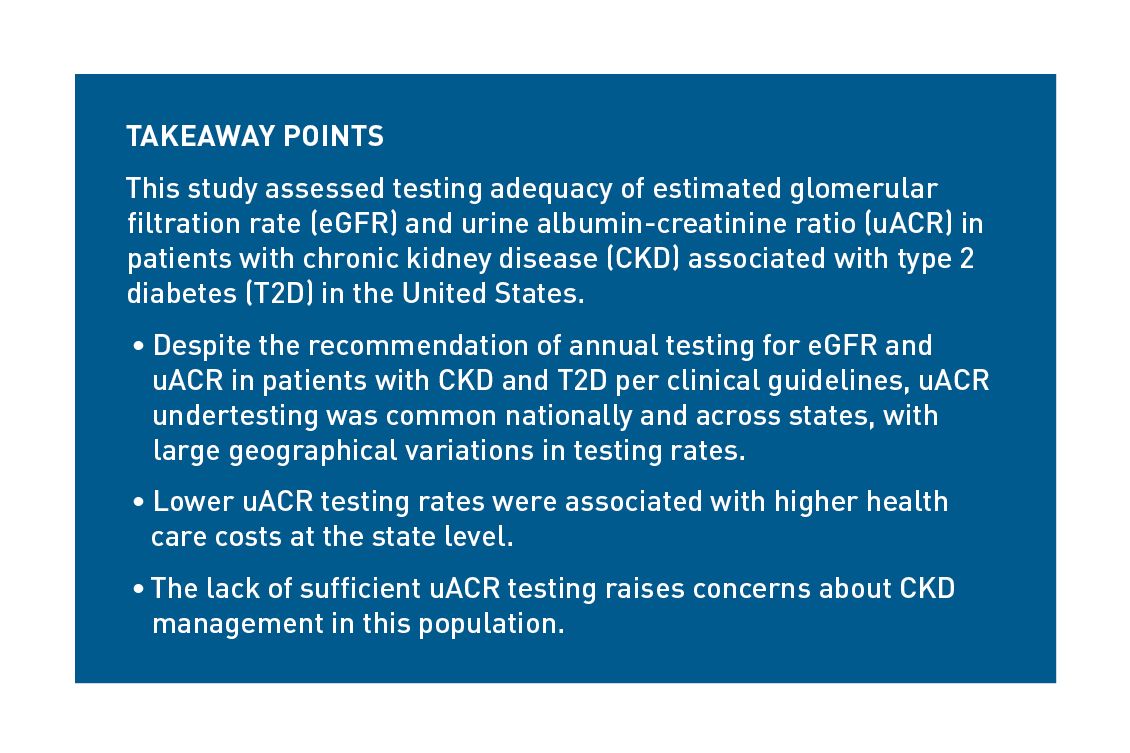
Methods
Data Source
This retrospective cohort study used anonymized patient-level data from the Optum Clinformatics database spanning January 2015 to December 2019. This claims database is a single-payer source of administrative health claims from enrollees across all of the United States; it includes over 51 million commercial health plan beneficiaries and Medicare Advantage enrollees. Administrative claims contained comprehensive, longitudinal information from verified and adjudicated medical and pharmacy claims. As the data were de-identified, no institutional board review was required.
Study Population
The study population was composed of adults (age on the index date [defined below], ≥ 18 years) with CKD and T2D between January 2015 to December 2019. Patients with T2D were identified using diagnostic codes and medications for T2D (eAppendix Table 1) based on a modified version of the Electronic Medical Records and Genomics algorithm.34 Patients with diagnosis codes for type 1 and other categories of diabetes were excluded. Patients with CKD were defined as those with at least 1 inpatient or at least 2 outpatient claims on distinct dates with diagnosis codes for CKD (eAppendix Table 1).
The study period was the 1-year span after the first (index) date when both the CKD and T2D definitions were met. Patients eligible for inclusion were required to have full continuous insurance enrollment during the 1-year study period. Patients with end-stage kidney disease (ESKD; on dialysis or prior kidney transplantation) before the index date or during the study period were excluded from the study sample, as their testing requirements differed from those of patients with CKD stages G1 to G5.
Testing for eGFR and uACR
The eGFR tests were identified using serum creatinine laboratory tests, and uACR tests were identified using urine albumin tests and urine creatinine tests obtained on the same day (test codes are listed in eAppendix Table 1). Testing rate (ie, the proportion of patients who received ≥ 1 test during the 1-year follow-up period), testing frequency, and monitoring adequacy (ie, the proportion of patients who had adequacy testing per CKD G stage) during the 1-year study period were assessed.
Adequate monitoring was defined by CKD G stage, which was derived based on the KDIGO clinical guidelines.3 Specifically, on an annual basis, at least 1 measurement of eGFR and at least 1 measurement of uACR are recommended for CKD stages G1 and G2, at least 2 measurements of eGFR and at least 2 measurements of uACR are recommended for CKD stage G3, at least 3 measurements of eGFR and at least 3 measurements of uACR are recommended for CKD stage G4, and at least 4 measurements of eGFR and at least 4 measurements of uACR are recommended for CKD stage G5. Testing performed less frequently than recommended by the most recent KDIGO clinical guidelines3 for the CKD stage were considered inadequate.
Total Health Care Costs
Total health care costs, including medical (ie, inpatient, outpatient, emergency department visits, and other costs) and pharmacy expenditures, were assessed for each state during the study period. All costs were calculated based on a US payer’s perspective and were inflated to 2020 US dollars using the medical care component of the Consumer Price Index.35
Statistical Analyses
Descriptive analyses were performed for patient characteristics (ie, age, race/ethnicity, and CKD G stage) as well as uACR and eGFR annual testing rates (ie, proportion of patients undergoing ≥ 1 test), annual testing frequencies, annual monitoring adequacy, and the annual total all-cause health care costs by state. Means and standard deviations (SD) were presented for continuous variables, and frequency counts and percentages were reported for categorical variables. Subgroup analyses were conducted by age group (< 55 years, 55 to < 65 years, 65 to < 75 years, and ≥ 75 years), race/ethnicity group (White, Black, Asian, and Hispanic patients), and CKD G stages. Heat maps were generated to demonstrate the variation in testing rate, monitoring adequacy, and annual total health care costs across states. A Pearson correlation (r) was estimated for the cost-uACR testing rates association at the state level. States contributing less than 200 patients were excluded from the state-level cost analyses. A P value of less than .05 indicated statistical significance.
SAS version 9.4 (SAS Institute Inc) was used for all statistical analyses. The heat maps were generated in R software version 3.6.3 (The R Foundation).
Results
Patient Characteristics
A total of 101,057 US adults with both CKD and T2D were included in the study (Figure 1). Patient baseline characteristics are listed in Table 1. The majority of patients in the sample were aged at least 65 years (80.1%), and 55.8% were White individuals. At the index date, 78.8% (n = 79,624) of patients had a diagnosis record indicating their CKD G stage. Among them, 5.1% were in CKD stage G1, 20.9% were in stage G2, 68.6% were in stage G3, and 5.4% were in stage G4 or G5.
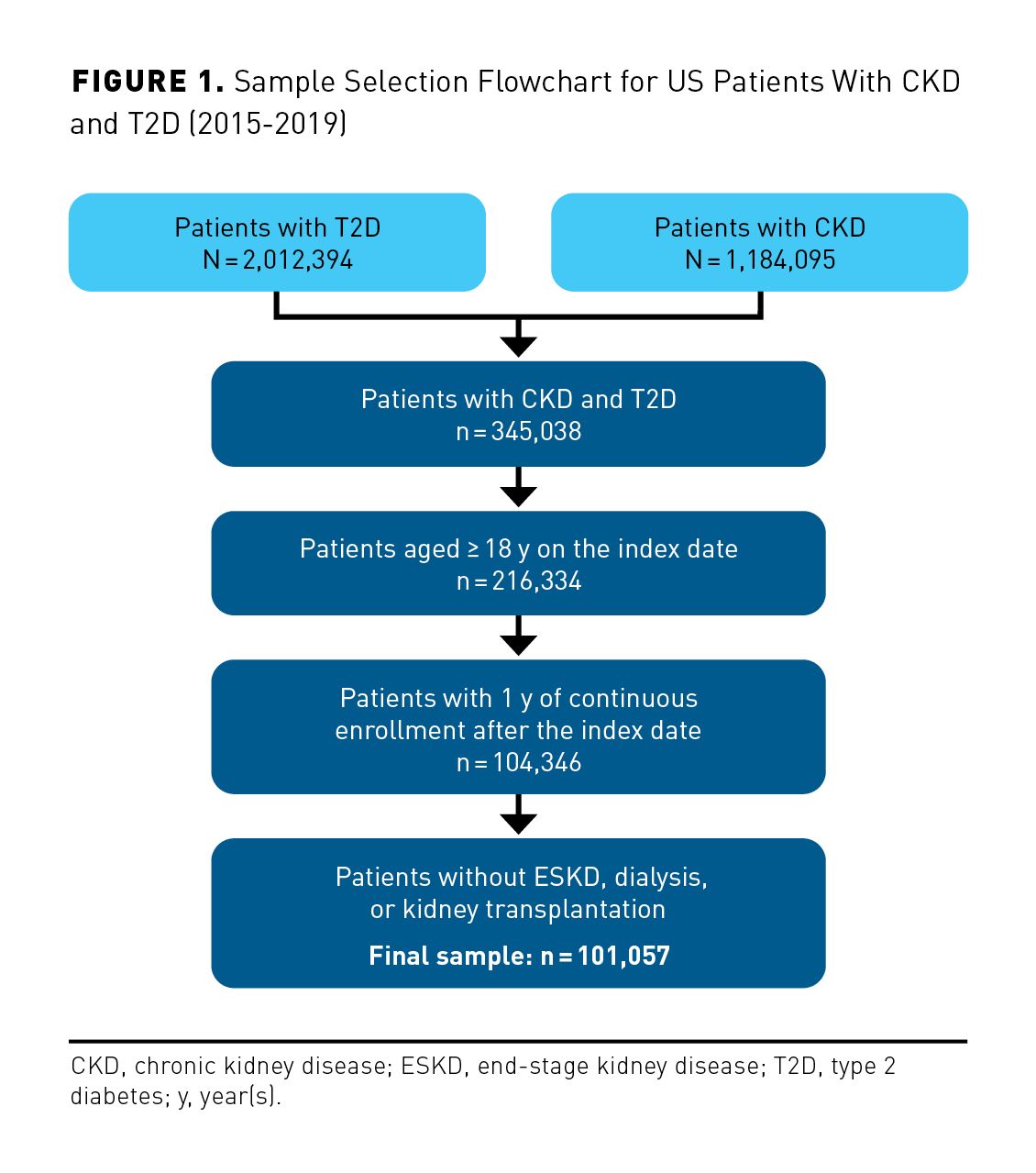
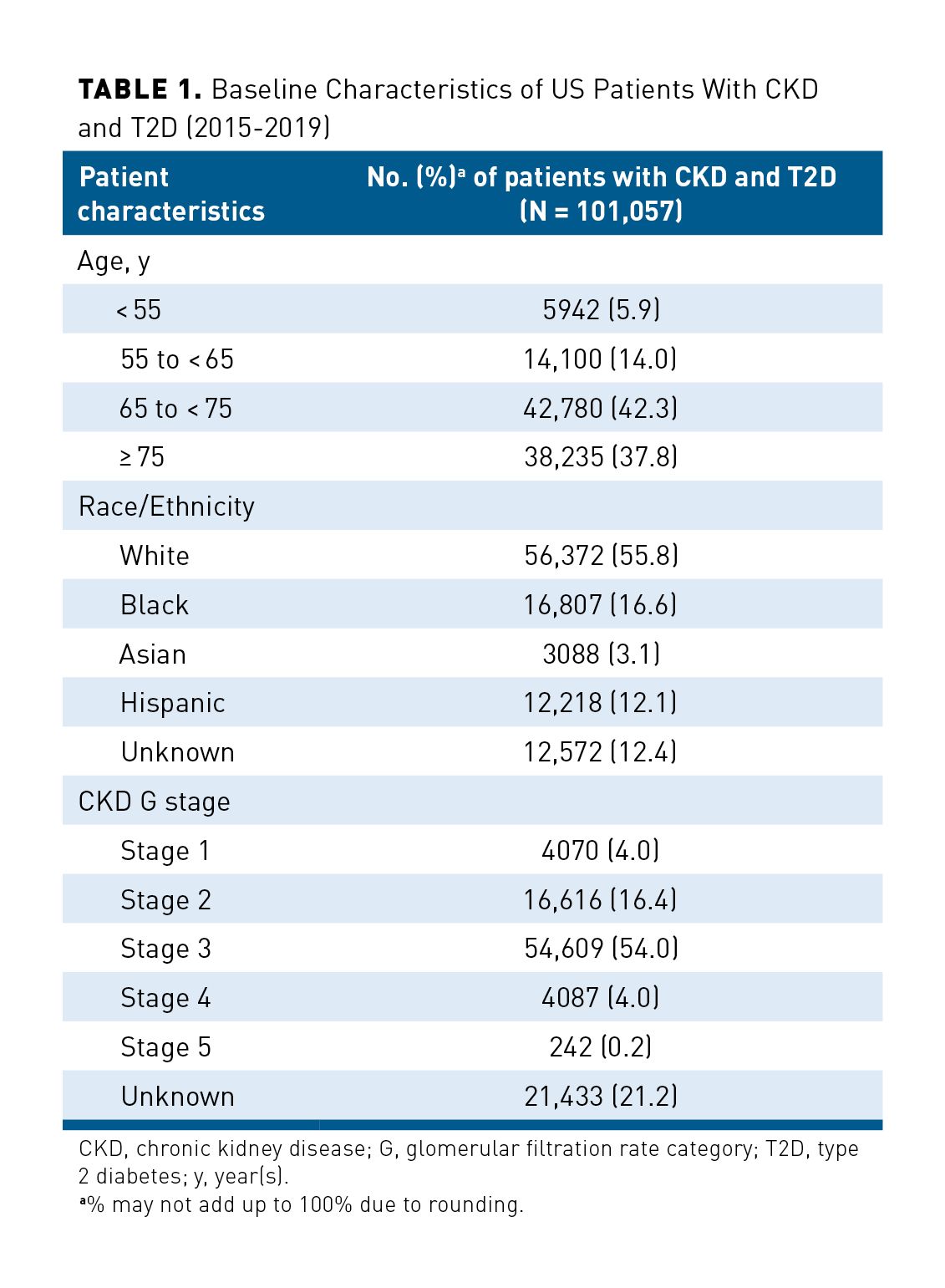
Testing Patterns
National patterns. During the 1-year study period, the eGFR testing rate (ie, the proportion of patients with ≥ 1 test over a 1-year follow-up period) was 94.1% (n = 95,101), and the average annual testing frequency was 4.2 (SD, 4.0) tests. The proportion of patients with adequate eGFR monitoring was 86.6% (n = 68,937). For uACR, the testing rate was 38.7% (n = 39,092), and the average annual testing frequency was 0.6 (SD, 0.9) tests. Only 20.3% (n = 16,161) of patients had adequate uACR monitoring.
Patterns by age, racial group, and CKD stage. The subgroup analyses were generally consistent with the national results, with high eGFR and low uACR testing rates observed across age and racial/ethnic subgroups (eAppendix Table 2). The eGFR testing rates were consistently high across CKD G stages (eAppendix Table 3), whereas the proportion of patients with adequate eGFR monitoring based on KDIGO guidelines was lower among patients with higher CKD G stages (58.3% in stage G5) compared with those with less advanced stages (90.0% in stage G1), as higher stages required more frequent monitoring. The uACR testing rates were generally very low across all CKD G stages. Particularly, substantially lower proportions of adequate uACR monitoring were observed among patients with higher CKD G stages (stage G4, 5.8%; stage G5, 2.5%).
State-level patterns. The eGFR and uACR testing rates and monitoring adequacy by state are displayed as heat maps in Figure 2 (eGFR) and Figure 3 (uACR). Overall, the eGFR testing rates were high across states, ranging from 79.5% (Colorado) to 97.3% (Alabama); monitoring adequacy was highest in southeastern states and lowest in midwestern states. Conversely, the uACR testing rates were much lower and displayed larger variations. The 3 states with the highest uACR testing rates were Hawaii (58.9%), Utah (53.1%), and Washington (52.6%); the states with the lowest uACR testing rates were Maine (14.0%), Arkansas (19.8%), and Minnesota (20.1%). Overall, the central and midwestern states had the lowest uACR testing rates. The proportion of patients with adequate testing for uACR was lowest in Minnesota (7.1%) and highest in Florida (30.9%).
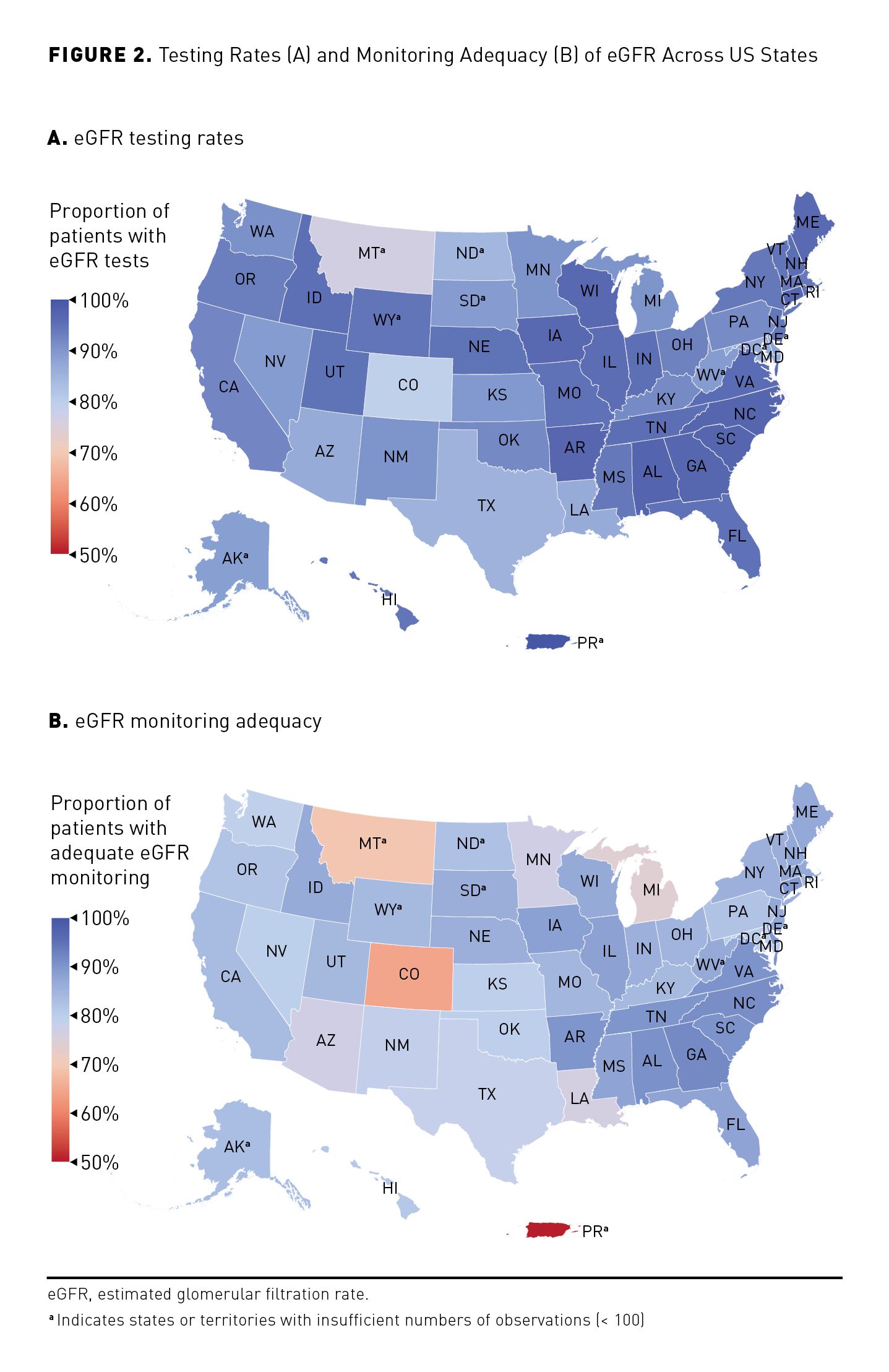
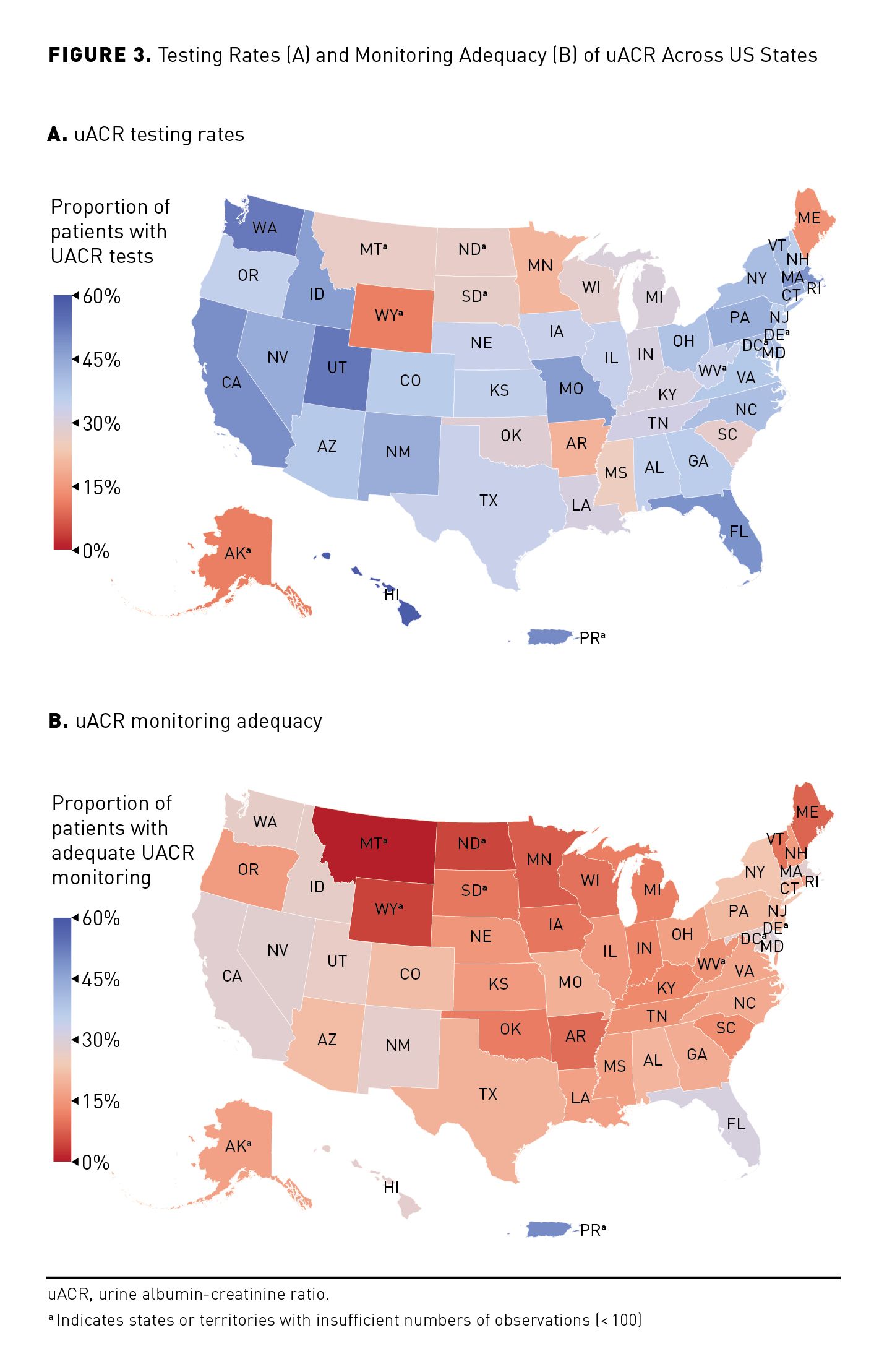
Economic Burden
Among the 101,057 patients with CKD and T2D, the average annual health care costs were $28,636. Costs increased with CKD severity, from $20,122 in stage 1 (n = 4070) to $38,072 in stage 5 (n = 242, excluding patients with ESKD). The high health care costs were largely driven by inpatient costs ($12,032), which accounted for 42% of the total annual health care costs, followed by outpatient costs ($9923) and pharmacy costs ($5391).
Large geographical variations in health care costs were observed across states (Figure 4A). After excluding states with small sample sizes (ie, n < 200), the 3 states with the highest health care costs were Illinois ($35,995), Kentucky ($34,245), and Oklahoma ($33,557); the states with the lowest health care costs were Hawaii ($21,003), Arizona ($22,052), and Utah ($22,631). No clear relationship between costs and eGFR testing rates was observed (Pearson r = 0.27; P = .09), whereas higher costs were correlated with lower uACR testing rates (Pearson r = –0.55; P < .01) (Figure 4B).
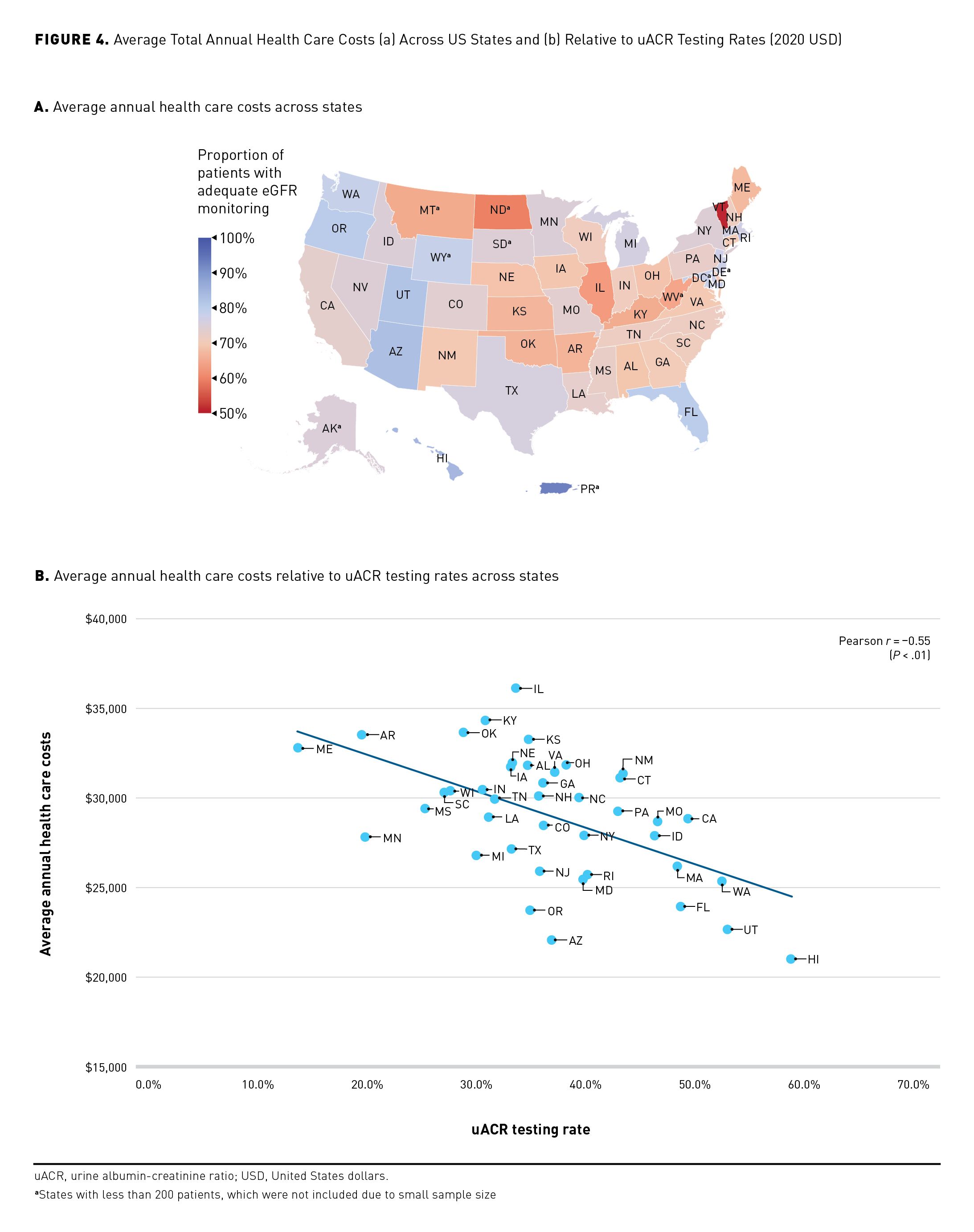
Discussion
Using real-world data from patients with CKD and T2D in a large US administrative claims database, this study characterized uACR and eGFR testing patterns nationally and across US states; it also delved into the relationship between testing rates and all-cause health care costs. Nationally, eGFR testing rates were high for this patient population—94.1% received at least 1 test, and 86.6% received adequate testing—with moderate variation noted across states (79.5%-97.3%). In contrast with the eGFR testing patterns, the rates for uACR testing were low nationally (38.7% had ≥ 1 test) and had larger variations between states (14.0%-58.9%).
Albuminuria, measured by the uACR tests, plays an important role in the management of patients with CKD associated with T2D.1,4,7 An elevated uACR is an independent predictor of poor cardiovascular outcomes and is associated with higher morbidity and risk of mortality.32,33 However, despite the importance of controlling albuminuria in patients with CKD associated with T2D,25 inadequate uACR testing was ubiquitous. Previous studies have reported low rates of uACR screening or testing among patients with T2D who are at risk of developing, but who have not yet received a diagnosis of, CKD. Other investigations assessing CKD monitoring in a T2D population with a previous CKD diagnosis also found that uACR was largely undertested despite clinical practice guideline recommendations.30,31 The severe undertesting of uACR observed in this study and others raises concerns about management of these patients, especially when the observed association between a low uACR testing rate and higher state-level health care costs are considered.
As changes in albuminuria are predictive for CKD progression, treatment decisions made in the absence of uACR testing data may delay proper treatment and, in turn, lead to higher health care costs due to CKD progression.36 On the other hand, timely initiation of treatments that control elevated albuminuria can improve disease outcomes and potentially lower downstream health care costs. Recent clinical practice guidelines recommend reduction in albuminuria as a therapeutic target.23-26,37 For example, angiotensin-converting enzyme inhibitors or angiotensin II type 1 receptor blockers yield significant kidney and cardiovascular protective effects, reducing the risk of ESKD and costly dialysis or kidney transplantation in patients with CKD, albuminuria, and T2D.38,39 Finerenone and SGLT2 inhibitors also demonstrate clinical benefits in preventing cardiovascular events, slowing the progression of kidney disease, and reducing risk of death in patients with CKD and T2D.40-43 The present findings emphasize the need to monitor patients with CKD adequately to reduce health care costs and improve patient outcomes through early detection of progression and prompt treatment initiation.
Furthermore, the low rates of uACR testing in the United States suggest that there may be barriers to adequate testing.7 Unlike eGFR, which is calculated using serum creatinine level included in the basic metabolic panel for blood tests, uACR results are specific to kidney disease and found via a urine test.44 Therefore, the low uACR testing rate could be due to infrequent visits to a nephrologist or low awareness of the importance of urine testing and uACR among patients and clinicians of other specialties.45 Inadequate testing of albuminuria in T2D may lead to underdiagnosis of CKD, consequently limiting patient awareness of CKD.46 According to a survey of US adults with CKD by Dharmarajan et al, only 15% of individuals with diabetes reported being aware of their CKD status.47 Of note, the present study observed lower uACR testing rates in the central, and predominantly rural, United States. As reported in a study by Naylor et al, individuals in these regions may have relatively lower access to health care resources, and particularly to specialists, when compared with those in the rest of the United States.45
This study benefits from several strengths. First, a large US claims database (Optum Clinformatics) was used to assess the testing patterns and health care costs for patients with CKD and T2D. The extensive dataset permitted both a large study sample covering all US geographical regions and the construction of subgroups for more detailed analyses. Second, in addition to eGFR testing, this study evaluated the patterns and adequacy of uACR testing in the CKD and T2D population across US states, which is an understudied area. The results suggested unmet needs in the management and monitoring of this patient population, which could inform clinical practice. Finally, we characterized the economic burden of CKD across US states and its association with both eGFR and uACR testing, which could inform health care resource allocation or promote costs savings by increasing awareness.
Limitations
Despite these strengths, the results of this study should be considered in the light of its limitations. First, as with all claims database analyses, medical services and laboratory tests obtained outside a patient’s plan were not captured. Further, coding inaccuracy and errors may have led to misclassifications of patients identified based on diagnostic codes; in particular, this may pertain to information on CKD G stage. Similarly, kidney function tests identified based on test codes may be subject to nondifferential measurement error. To address this limitation, 2 outpatient CKD diagnoses were required to reduce potential errors. Second, the study excluded patients with ESKD (dialysis or had kidney transplantation), whereas a small group of patients (n = 242) with CKD stage G5 who did not have evidence of ESKD were included. Thus, this may not be a representative sample of all patients with CKD stage G5. Third, because of the ecological study design, potential confounding may exist and mitigate findings, particularly for the relationship between kidney function testing patterns and economic outcomes. Finally, the study results cannot be used to directly infer the underlying reasons for inadequate uACR testing. To improve CKD management and awareness of ideal patient monitoring, future studies are warranted to assess contributing factors to low rates of uACR testing and to inform policy-making.
Conclusions
Among US patients with both CKD and T2D, severe undertesting for uACR was observed nationally and across all states, and large geographical variations in testing rates were revealed. Lower uACR testing rates were associated with higher state-level health care costs. This lack of sufficient uACR testing raises concerns about the management of CKD in patients with T2D.
Acknowledgements: Medical writing was provided by Shelley Batts, PhD, an employee of Analysis Group, Inc, and funded by Bayer US, LLC. The authors would like to thank Yao Wang and Sophie Gao, employees of Analysis Group, Inc, and Yuejun Chen, an employee of Analysis Group Inc during the study’s conduct, for assistance with the analysis and preparation of the manuscript.
Data Sharing Statement: The study was conducted using commercially licensed de-identified individual patient level data. Data used in this study are not available for public access.
Author Affiliations: Analysis Group, Inc (KAB, JS, AW), Los Angeles,CA; Bayer US, LLC (RF, NW, RS), Whippany, NJ; Myriad Neuroscience (JE), Mason, OH.
Funding Source:This study was supported by Bayer US, LLC. The sponsor was involved in the study design, analysis, and interpretation of data, writing the manuscript, and the decision to submit the report for publication.
Author Disclosures: Dr Betts, Dr Song, and Dr Wu are employed by and report institutional conflicts of interest with Analysis Group, Inc, which received consulting fees from Bayer US, LLC for this work. Dr Elliot was employed by Bayer US, LLC at the time of the study and owns stock in Bayer US, LLC. Farej, Dr Singh, and Dr Warnock are employed by and report institutional conflicts of interest with Bayer US, LLC, such as US and EU approval of a product for chronic kidney disease in type 2 diabetes.
Authorship Information: Concept and design (KAB, JS, JE, NW, RF, AW, RS); acquisition of data (RS); analysis and interpretation of data (KAB, JS, JE, RF, AW, RS); drafting of the manuscript (KAB, NW, AW); critical revision of the manuscript for important intellectual content (KAB, JS, JE, NW, RF, AW, RS); statistical analysis (JS, AW); administrative, technical, or logistic support (RF, RS); and supervision (KAB, JS, RS).
Address Correspondence to: Rakesh Singh, PhD, Bayer US, LLC, 100 Bayer Blvd., Whippany, NJ 07981. Email: rakesh.singh1@bayer.com
REFERENCES
1. de Boer IH, Caramori ML, Chan JCN, Heerspink HJL, Hurst C, Khunti K, et al; Kidney Disease: Improving Global Outcomes (KDIGO) Working Group. KDIGO 2020 Clinical Practice Guideline for Diabetes Management in Chronic Kidney Disease. Kidney Int. 2020;98(4):S1-S115. doi:10.1016/j.kint.2020.06.019
2. Levey AS, Becker C, Inker LA. Glomerular filtration rate and albuminuria for detection and staging of acute and chronic kidney disease in adults: a systematic review. JAMA. 2015;313(8):837-846. doi:10.1001/jama.2015.0602
3. Kidney Disease: Improving Global Outcomes (KDIGO) CKD Work Group. KDIGO 2012 clinical practice guideline for the evaluation and management of chronic kidney disease. Kidney Int Suppl. 2013;3(1):1-150. doi:10.1038/kisup.2012.73
4. National Kidney Foundation’s Kidney Disease Outcomes Quality Initiative (KDOQI). KDOQI clinical practice guidelines and clinical practice recommendations for diabetes and chronic kidney disease. Am J Kidney Dis. 2007;49(2; suppl 2):S12-154. doi:10.1053/j.ajkd.2006.12.005
5. Mogensen C, Chachati A, Christensen CK, et al. Microalbuminuria: an early marker of renal involvement in diabetes. Uremia Invest. 1985-1986;9(11):85-95. doi:10.3109/08860228509088195
6. Abe M, Okada K, Maruyama N, Takashima H, Oikawa O, Soma M. Comparison of clinical trajectories before initiation of renal replacement therapy between diabetic nephropathy and nephrosclerosis on the KDIGO guidelines heat map. J Diabetes Res. 2016;2016:5374746. doi:10.1155/2016/5374746
7. Christofides EA, Desai N. Optimal early diagnosis and monitoring of diabetic kidney disease in type 2 diabetes mellitus: addressing the barriers to albuminuria testing. J Prim Care Community Health. 2021;12:21501327211003683. doi:10.1177/21501327211003683
8. Chen TK, Knicely DH, Grams ME. Chronic kidney disease diagnosis and management: a review. JAMA. 2019;322(13):1294-1304. doi:10.1001/jama.2019.14745
9. Zelnick LR, Weiss NS, Kestenbaum BR, et al. Diabetes and CKD in the United States population, 2009-2014. Clin J Am Soc Nephrol. 2017;12(12):1984-1990. doi:10.2215/CJN.03700417
10. Centers for Disease Control and Prevention. National diabetes statistics report: estimates of diabetes and its burden in the United States. 2020. Accessed June 13, 2022. 2020. https://www.cdc.gov/diabetes/data/statistics-report/index.html
11. Type 2 diabetes. Centers for Disease Control and Prevention. Reviewed December 16, 2021. Accessed April 25, 2022. https://www.cdc.gov/diabetes/basics/type2.html
12. Betônico CCR, Titan SMO, Correa-Giannella MLC, Nery M, Queiroz M. Management of diabetes mellitus in individuals with chronic kidney disease: therapeutic perspectives and glycemic control. Clinics (San Paulo). 2016;71:47-53. doi:10.6061/clinics/2016(01)08
13. Chronic kidney disease in the United States, 2021. Centers for Disease Control and Prevention. Reviewed March 4, 2021. Accessed June 13, 2022. https://www.cdc.gov/kidneydisease/publications-resources/ckd-national-facts.html
14. Fox CS, Matsushita K, Woodward M, et al. Associations of kidney disease measures with mortality and end-stage renal disease in individuals with and without diabetes: a meta-analysis. Lancet. 2012;380(9854):1662-1673. doi:10.1016/s0140-6736(12)61350-6
15. Afkarian M, Sachs MC, Kestenbaum B, et al. Kidney disease and increased mortality risk in type 2 diabetes. J Am Soc Nephrol. 2013;24(2):302-308. doi:10.1681/asn.2012070718
16. Coresh J, Selvin E, Stevens LA, et al. Prevalence of chronic kidney disease in the United States. JAMA. 2007;298(17):2038-2047. doi:10.1001/jama.298.17.2038
17. Kidney disease statistics for the United States. National Institute of Diabetes and Digestive and Kidney Diseases. Reviewed September 2021. Accessed April 25, 2022. https://www.niddk.nih.gov/health-information/health-statistics/kidney-disease
18. Tonelli M, Wiebe N, Culleton B, et al. Chronic kidney disease and mortality risk: a systematic review. Am J Soc Nephrol. 2006;17(7):2034-2047. doi:10.1681/asn.2005101085
19. United States Renal Data System. 2021 USRDS annual data report: epidemiology of kidney disease in the United States. National Institutes of Health, National Institute of Diabetes and Digestive and Kidney Diseases. 2021. Accessed April 11, 2022. https://adr.usrds.org/2021
20. Nichols GA, Ustyugova A, Déruaz-Luyet A, O’Keeffe-Rosetti M, Brodovicz KG. Health care costs by type of expenditure across eGRF stages among patients with and without diabetes, cardiovascular disease, and heart failure. J Am Soc Nephrol. 2020;31(7):1594-1601. doi:10.1681/asn.2019121308
21. Folkerts K, Petruski-Ivleva N, Kelly A, et al. Annual health care resource utilization and cost among type 2 diabetes patients with newly recognized chronic kidney disease within a large U.S. administrative claims database. J Manag Care Spec Pharm. 2020;26(12):1506-1516. doi:10.18553/jmcp.2020.26.12.1506
22. Qaseem A, Hopkins RH Jr, Sweet DE, Starkey M, Shekelle P; Clinical Guidelines Committee of the American College of Physicians. Screening, monitoring, and treatment of stage 1 to 3 chronic kidney disease: a clinical practice guideline from the American College of Physicians. Ann Intern Med. 2013;159(12):835-847. doi:10.7326/0003-4819-159-12-201312170-00726
23. National Clinical Guideline Centre (UK); National Institute for Health and Care Excellence. Clinical guidelines. In: Chronic Kidney Disease (Partial Update): Early Identification and Management of Chronic Kidney Disease in Adults in Primary and Secondary Care. PubMed.gov. July 2014. Accessed April 25, 2022. https://pubmed.ncbi.nlm.nih.gov/25340245/
24. Wouters OJ, O’Donoghue DJ, Ritchie J, Kanavos PG, Narva AS. Early chronic kidney disease: diagnosis, management and models of care. Nat Rev Nephrol. 2015;11(8):491-502. doi:10.1038/nrneph.2015.85
25. American Diabetes Association Professional Practice Committee; Draznin B, Aroda VR, Bakris G, et al. 11. Chronic kidney disease and risk management: standards of medical care in diabetes-2022. Diabetes Care. 2022;45(suppl 1):S175-S184. doi:10.2337/dc22-S011
26. Mottl AK, Alicic R, Argyropoulos C, et al. KDOQI US commentary on the KDIGO 2020 clinical practice guideline for diabetes management in CKD. Am J Kidney Dis. 2022;79(4):457-479. doi:10.1053/j.ajkd.2021.09.010
27. Liu HH, Zhao S. Savings opportunity from improved CKD care management. J Am Soc Nephrol. 2018;29(11):2612-2615. doi:10.1681/ASN.2017121276
28. Smart NA, Dieberg G, Ladhani M, Titus T. Early referral to specialist nephrology services for preventing the progression to end-stage kidney disease. Cochrane Database Syst Rev. 2014;(6):CD007333. doi:10.1002/14651858.CD007333.pub2
29. Stroupe KT, Fischer MJ, Kaufman JS, et al. Predialysis nephrology care and costs in elderly patients initiating dialysis. Med Care. 2011;49(3):248-256. doi:10.1097/MLR.0b013e31820192ba
30. Folkerts K, Petruski-Ivleva N, Comerford E, et al. Adherence to chronic kidney disease screening guidelines among patients with type 2 diabetes in a US administrative claims database. Mayo Clin Proc. 2021;96(4):975-986. doi:10.1016/j.mayocp.2020.07.037
31. Saran R, Robinson B, Abbott KC, et al. US renal data system 2019 annual data report: epidemiology of kidney disease in the United States. Am J Kidney Dis. 2020;75(1; suppl 1):A6-A7. doi:10.1053/j.ajkd.2019.09.003
32. Stempniewicz N, Vassalotti JA, Cuddeback JK, et al. Chronic kidney disease testing among primary care patients with type 2 diabetes across 24 U.S. health care organizations. Diabetes Care. 2021;44(9):2000-2009. doi:10.2337/dc20-2715
33. Alfego D, Ennis J, Gillespie B, et al. Chronic kidney disease testing among at-risk adults in the U.S. remains low: real-world evidence from a national laboratory database. Diabetes Care. 2021;44(9):2025-2032. doi:10.2337/dc21-0723
34. Kho AN, Hayes MG, Rasmussen-Torvik L, et al. Use of diverse electronic medical record systems to identify genetic risk for type 2 diabetes within a genome-wide association study. J Am Med Inform Assoc. 2012;19(2):212-218. doi:10.1136/amiajnl-2011-000439
35. Consumer price index. United States Bureau of Labor Statistics. 2020. Accessed July 19, 2021. https://www.bls.gov/cpi/
36. Roscioni SS, Heerspink HJL, de Zeeuw D. Microalbuminuria: target for renoprotective therapy PRO. Kidney Int. 2014;86(1):40-49. doi: 10.1038/ki.2013.490.
37. Stevens PE, Levin A; Kidney Disease: Improving Global Outcomes Chronic Kidney Disease Guideline Development Work Group Members. Evaluation and management of chronic kidney disease: synopsis of the kidney disease: improving global outcomes 2012 clinical practice guideline. Ann Intern Med. 2013;158(11):825-830. doi:10.7326/0003-4819-158-11-201306040-00007
38. Arora N, Katz R, Bansal N. ACE inhibitor/angiotensin receptor blocker use patterns in advanced CKD and risk of kidney failure and death. Kidney Med. 2020;2(3):248-257. doi:10.1016/j.xkme.2019.12.007
39. Umanath K, Lewis JB. Update on diabetic nephropathy: core curriculum 2018. Am J Kidney Dis. 2018;71(6):884-895. doi:10.1053/j.ajkd.2017.10.026
40. Perkovic V, Jardine MJ, Neal B, Bompoint S, Heerspink HJL, Charytan DM, et al. Canagliflozin and renal outcomes in type 2 diabetes and nephropathy. N Engl J Med. 2019;380(24):2295-2306. doi:10.1056/NEJMoa1811744
41. Heerspink HJL, Stefansson BV, Correa-Rotter R, et al. Dapagliflozin in patients with chronic kidney disease. N Engl J Med. 2020;383(15):1436-1446. doi:10.1056/NEJMoa2024816
42. Wheeler DC, Stefansson BV, Jongs N, et al. Effects of dapagliflozin on major adverse kidney and cardiovascular events in patients with diabetic and non-diabetic chronic kidney disease: a prespecified analysis from the DAPA-CKD trial. Lancet Diabetes Endocrinol. 2021;9(1):22-31. doi:10.1016/S2213-8587(20)30369-7
43. Bakris GL, Agarwal R, Anker SD, et al. Effect of finerenone on chronic kidney disease outcomes in type 2 diabetes. N Engl J Med. 2020;383(23):2219-2229. doi:10.1056/NEJMoa2025845
44. Vassalotti JA, DeVinney R, Lukasik S, et al. CKD quality improvement intervention with PCMH integration: health plan results. American Journal of Managed Care®. November 8, 2019. Accessed April 25, 2022. https://www.ajmc.com/view/ckd-quality-improvement-intervention-with-pcmh-integration-health-plan-results
45. Naylor KB, Tootoo J, Yakusheva O, et al. Geographic variation in spatial accessibility of US healthcare providers. PLOS One. 2019;14(4):e0215016. doi:10.1371/journal.pone.0215016
46. Vassalotti JA, Argyropoulos C. Can community-based albuminuria testing improve care? Kidney Intl Rep. 2020;5(4):392-395. doi: 10.1016/j.ekir.2020.01.026.
47. Dharmarajan SH, Bragg-Gresham JL, Morgenstern H, et al. State-level awareness of chronic kidney disease in the US. Am J Prev Med. 2017;53(3):300-307. doi:10.1016/j.amepre.2017.02.015